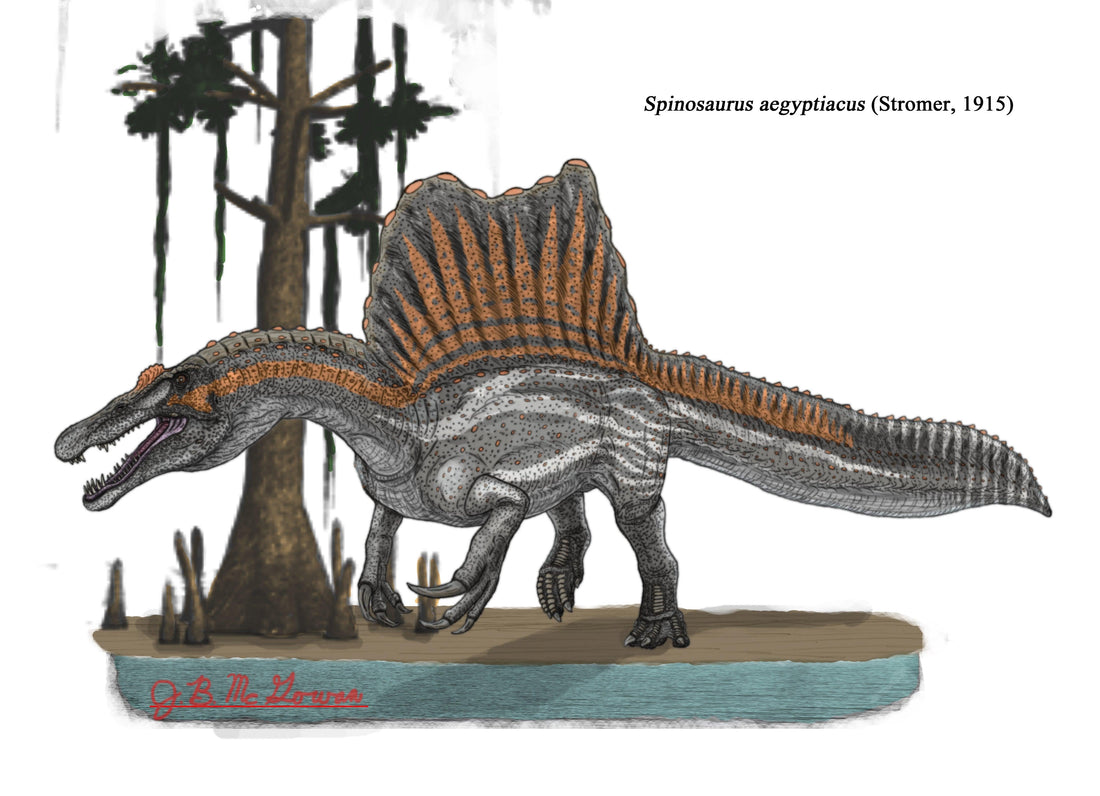
Hindsight with Dr. BC - January 2021
Share
Dr. BC shares with us 3 takes on the latest paleontological finds, new looks on old specimens, and other thoughts from the depths of his paleo-obsessed brain!
Spinosaurus: Ambush shore predator or aquatic pursuit predator?
Spinosaurus continues to baffle! The latest debate? Was it an ambush shore predator (a la herons and storks) or an aquatic pursuit predator (like a crocodile or an otter)? I'm taking my traditional "both" answer on this one.
Spinosaurus was over 50' long with massive claws, a long snout, and a variety of swimming adaptations like pachyostotic bones and probably webbed feet.
The new paper suggests it sat patiently on the water's edge like a Great Blue Heron or a 50' long stork and picked off prey. With a strong, s-shaped neck and a long snout with nostrils near the eyes, it certainly could have picked off critters from the shore like storks and herons today.
In my opinion, if it saw a big fish it wanted to eat, it could easily have plunged into the water and hunted it down, swimming with its powerful tail and, if in shallow water, using its wide feet and long arms with scythe-like claws to hunt down and gobble up the giant coelacanth Mawsonia.
it certainly wasn't as active as an otter or a porpoise and possibly not even as well-adapted to aquatic predation as a crocodile, but with a burst of speed and huge reach with its snout and neck, it would have an excellent chance of picking off big, slow-moving fish.
Life rarely is "either/or" when it comes to big animals, but framing the discussion as such, requires both sides to dig deep into the details, which makes the science better as a whole.
Dr. BC, was it better at one scenario than the other? That wasn't the initial question, so I'll keep my thoughts silent for now:-)!

Sexy, Toothy Wolves with Hooves Taken Down by a Mouse Deer
Mesonychids out, Indohyus and the Raoellids in! I have believed mesonychids gave rise to whales seemingly forever. It is a story I have told many times, how the "wolves with hooves" gave rise to the whales, and we know this thanks to the shape of their teeth. However, while researching the origin of baleen (yep, even in my spare time, I'm reading about this stuff :-)) I discovered about 10 years ago there was a massive paradigm shift regarding where whales came from.
Molecular evidence indicates whales are closely related to hippos, but the fossils suggest mesonychids are their relatives. This kind of bone vs. gene conflict happens regularly (Canis dirus vs. Aenocyon dirus, anyone?), and it can't be helped. If anything, it will become more prevalent as the ability to extract genetic material from fossils improves.
As fate had it, a student was preparing a fossil and broke the skull's ear bone open (it happens) and the supervisor recognized the bone as one having characteristics of a whale. The bone belonged to Indohyus, an ultra-cute, cat-sized, deer-like animal of which they fortunately had a partial skeleton of, including the ankle. To be a whale, one needs to have a special kind of ear bone, and, as an added bonus, early whales (the ones with working legs) also have a unique ankle. Indohyus had both! This provided fossil corroboration of the genetic data as the Raoelleids were known to be semi-aquatic mammals distantly related to hippos. I was delighted to learn this new-to-me info but saddened to see whales not deriving from the only toothed, hoofed critters.

Megalodon: Cannibalism in the womb
Megalodon (Otodus megalodon) is the largest predatory shark at over 50' long! It had the most powerful bite of any predator that ever lived, strong enough to bite through the chest of a whale to reach its heart and lungs. Everything was massive about Megalodon, including its babies, which were born nearly 7' long and 500 lbs. They attained such a giant size by eating their siblings! Otodus megalodon is the stuff dreams (or nightmares) are made of.
The largest predatory shark ever discovered, its upper size limits have been debated for years. A paper by Dr. Shimada came out this month that looked at the "growth rings" of an extremely rare series of over 100 vertebrae excavated in the early 1900s in Belgium. Shark skeletons are made of cartilage, so they almost never preserve, but in this case, a Megalodon shark died and sank into a patch of water that seems to have been calcium-rich and turned the cartilage to bone.
The backbones let Dr. Shimada and his team count growth rings to determine how old the shark was when it died. In modern sharks, a concentric ring is added once a year. With over 100 vertebrae, they were able to determine the size of the shark, and because they knew the age of the shark by counting the growth rings, they were able to determine how fast it grew.
By looking at the size of the center of the vertebra (which is the first growth ring) they could tell how large the shark was when it was born (very cool!) and discovered it was 7' long and around 500 lbs. Some of today's sharks practice cannibalism in the womb, where siblings eat their siblings until there is only one (or a few if they are equally matched) left. This extra protein lets them be born at a large size, allowing them a greater chance to survive. Though it had long been suspected this was the case with Megalodon, this paper demonstrated they were born large, verifying this hypothesis.